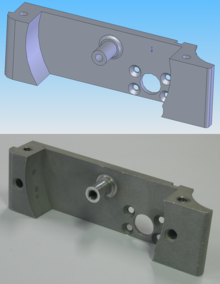
Back تصنيع بمساعدة الحاسوب Arabic Avtomatlaşdırılmış istehsal Azerbaijani Fabricació assistida per ordinador Catalan Computer aided manufacturing Czech Computerstøttet fremstilling Danish Computer-aided manufacturing German Fabricación asistida por computadora Spanish Raaltootmine Estonian Ordenagailuz lagundutako fabrikazio Basque ساخت به کمک رایانه Persian
This article needs additional citations for verification. (October 2009) |

Computer-aided manufacturing (CAM) also known as computer-aided modeling or computer-aided machining[1][2][3] is the use of software to control machine tools in the manufacturing of work pieces.[4][5][6][7][8] This is not the only definition for CAM, but it is the most common.[4] It may also refer to the use of a computer to assist in all operations of a manufacturing plant, including planning, management, transportation and storage.[9][10] Its primary purpose is to create a faster production process and components and tooling with more precise dimensions and material consistency, which in some cases, uses only the required amount of raw material (thus minimizing waste), while simultaneously reducing energy consumption.[citation needed] CAM is now a system used in schools and lower educational purposes.[where?] CAM is a subsequent computer-aided process after computer-aided design (CAD) and sometimes computer-aided engineering (CAE), as the model generated in CAD and verified in CAE can be input into CAM software, which then controls the machine tool. CAM is used in many schools alongside CAD to create objects.
- ^ Mörmann, W. H.; Bindl, A. (2002). "All-ceramic, chair-side computer-aided design/computer-aided machining restorations". Dental Clinics of North America. 46 (2): 405–26, viii. doi:10.1016/S0011-8532(01)00007-6. PMID 12014040.
- ^ "Method and apparatus for computer aided machining". 16 September 1997.
- ^ Yong, Loong Tee; Moy, Peter K. (2008). "Complications of Computer-Aided-Design/Computer-Aided-Machining-Guided (NobelGuide™) Surgical Implant Placement: An Evaluation of Early Clinical Results". Clinical Implant Dentistry and Related Research. 10 (3): 123–127. doi:10.1111/j.1708-8208.2007.00082.x. PMID 18241215.
- ^ a b U.S. Congress, Office of Technology Assessment (1984). Computerized manufacturing automation. Diane Publishing. p. 48. ISBN 978-1-4289-2364-5.
- ^ Hosking, Dian Marie; Anderson, Neil (1992), Organizational change and innovation, Taylor & Francis, p. 240, ISBN 978-0-415-06314-2
- ^ Daintith, John (2004). A dictionary of computing (5 ed.). Oxford University Press. p. 102. ISBN 978-0-19-860877-6.
- ^ Kreith, Frank (1998). The CRC handbook of mechanical engineering. CRC Press. p. 15-1. ISBN 978-0-8493-9418-8.
- ^ Matthews, Clifford (2005). Aeronautical engineer's data book (2nd ed.). Butterworth-Heinemann. p. 229. ISBN 978-0-7506-5125-7.
- ^ Pichler, Franz; Moreno-Díaz, Roberto (1992). Computer aided systems theory. Springer. p. 602. ISBN 978-3-540-55354-0.
- ^ Boothroyd, Geoffrey; Knight, Winston Anthony (2006). Fundamentals of machining and machine tools (3rd ed.). CRC Press. p. 401. ISBN 978-1-57444-659-3.
© MMXXIII Rich X Search. We shall prevail. All rights reserved. Rich X Search